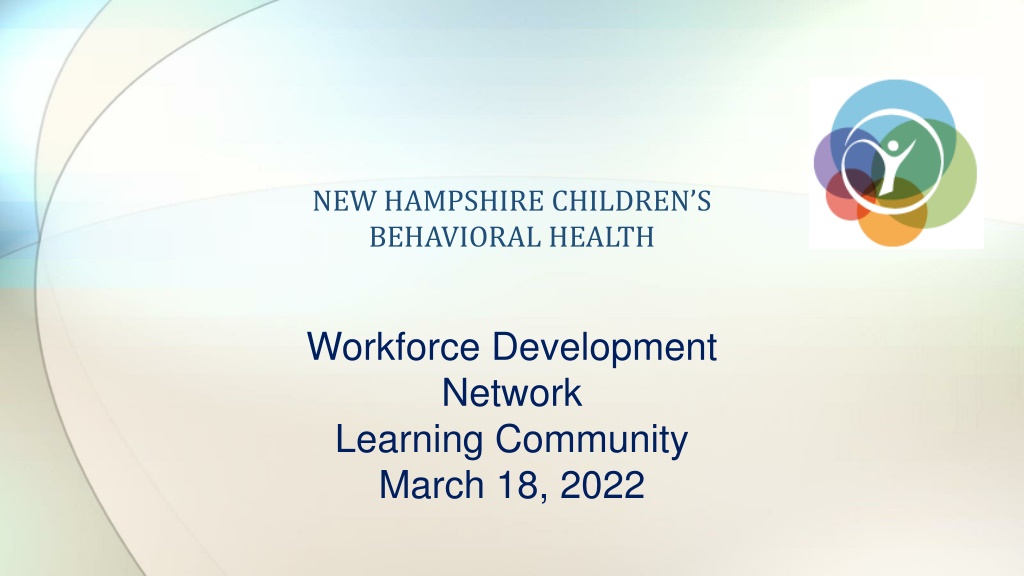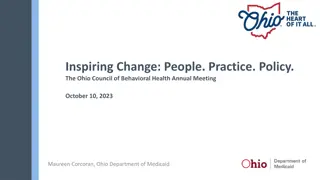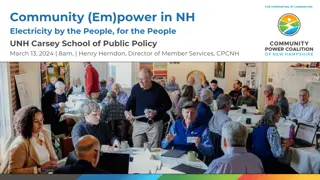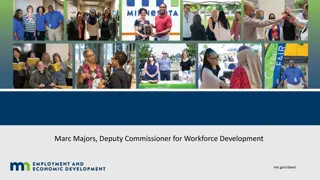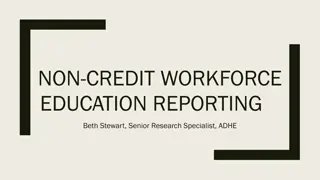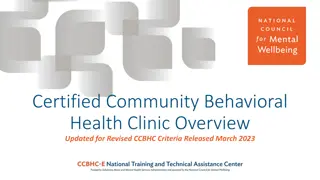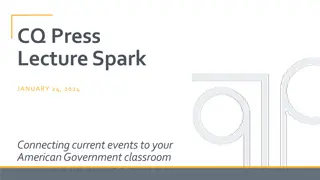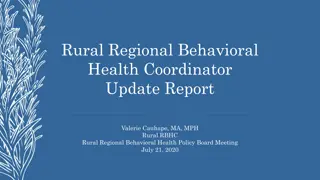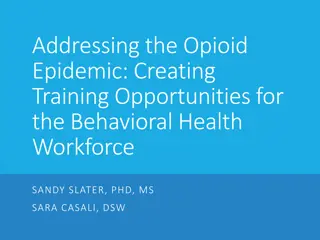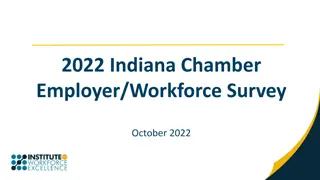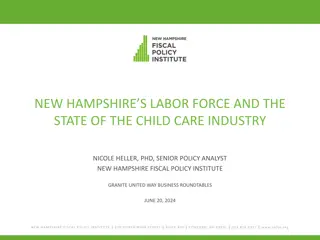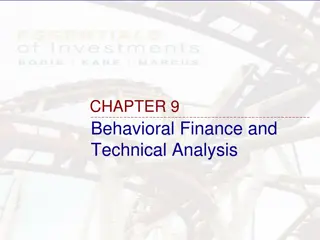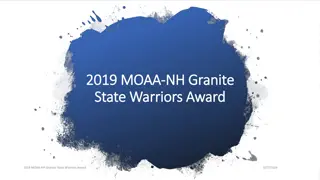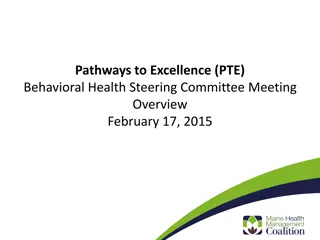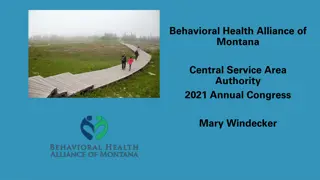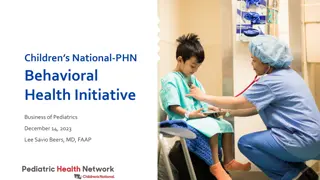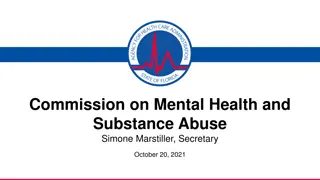New Hampshire Children's Behavioral Health Workforce Development Network Learning Community Update
The New Hampshire Children's Behavioral Health Workforce Development Network held a learning community meeting with various agenda items, including orientation, purpose and focus discussions, leadership planning, and adherence to collaborative work principles. The mission statement and collaborative approach were highlighted, emphasizing creating hope for better outcomes. The community also celebrated achievements such as the FAST Forward Wrap serving 450 families and comprehensive assessments for treatment. The shared ideas included bullet journaling, meditation, and the 5 AM Club for personal development. Overall, the community aims to improve outcomes for children and families through interdisciplinary workforce development activities.
Download Presentation

Please find below an Image/Link to download the presentation.
The content on the website is provided AS IS for your information and personal use only. It may not be sold, licensed, or shared on other websites without obtaining consent from the author. Download presentation by click this link. If you encounter any issues during the download, it is possible that the publisher has removed the file from their server.
E N D
Presentation Transcript
NEW HAMPSHIRE CHILDRENS BEHAVIORAL HEALTH Workforce Development Network Learning Community March 18, 2022
Are there days when you dont have enough time to think?
Ideas Bullet journal- mapping out the week Meditation Hidden Brain- multitasking Writing out everything in longhand The 5 Am Club - The Miracle Morning
Agenda 1. Orientation to our Learning Community- please come to share information about your workshops, trainings, etc. (45 minutes) 2. What is our purpose, what is our focus? Results of survey (30 min) BREAK 1. Leadership Institute plan and update (20 min) Next Steps
Mission Statement: The mission of the NHCBH Workforce Development Network is to create hope and improve outcomes for children, youth, young adults and their families by convening, promoting, developing, implementing, and disseminating interdisciplinary workforce development activities.
How we work together: Start and end on time Provide a clear agenda with times to help focus Provide resources/documents to be discussed at meeting ahead of time Allow for schmooze time during meetings Send email reminders of assignments to be completed Humor and jokes Be open minded and supportive, no idea is wrong Have a parking lot for items that can t be discussed immediately Encourage connections to other work that is going on the big picture link the threads
What is a Learning Collaborative? The Learning Collaborative (LC) approach focuses on spreading, adopting, and adapting best practices across multiple settings and creating changes in organizations that promote the delivery of effective interventions and services. Markiewicz, J., Ebert, L., Ling, D., Amaya-Jackson, L., & Kisiel, C. (2006). Learning Collaborative Toolkit. Los Angeles, CA, and Durham, NC: National Center for Child Traumatic Stress.
Celebrations and Updates CBBH: FAST Forward Wrap is serving 450 families; Comprehensive Assessment for Treatment- 65 assessment is February (3, 4 referrals). 321 assessments. Distribution for CAT assessments. Rapid Response--- What positions might be needed? Mid and entry level positions can be built through DOL apprenticeships. US DOE DHHS Office of personnel and apprenticeships. Partners often ask--- high potential staff or middle level managerial staff- is it possible to apprentice a manager?
Celebrations and updates Need to develop leaders . Tiered licensure (Board of MH practice) is on the horizon --- contributes to better satisfaction, ability to bill private insurance. NH/VT 12 hours supervision course. NH Workforce coalition- letter gone to commissioners and scholarships and training. (Dupont Group and Bi State lead it). Changing demographics- who is studying the shifting demographics in NH? Workforce initiatives are sector-based--- all siloed. Endowment for Health Forward Fund. Is studying all the initiatives and drafting a plan. Who will coordinate? Important target: Office of Professional Licensing. Gov s Commission on BH Workforce.
Updates Sector partnership has applied for the Good Jobs grant- offers funding for sector initiatives. (Health sector chair: Roxy Severance). Absence of child care.
Childrens System of Care Technical Assistance Center (CSOC TAC)
There is a need . For an intentional approach to implementation To help families and youth navigate the system. For person-centered, one stop navigation. For knowledge translation. Implementation frameworks is our technology. To convene and support providers, families, and other stakeholders. To Engage youth and families as full partners to identify what they need, and to decide what they receive, that they receive what they need, when they need it, and in the dosage they need and no more Institute on Disability / UCED at the University of New Hampshire s College of Health and Human Services
The Mission The Mission of the Children s System of Care TA Center (CSOC TAC) is to assess, improve, and build statewide capacity of providers to deliver high quality, research-based mental health and substance misuse treatment practices for children, youth, young adults, and families. 9/22/2024 13
Goals 1. Provide and support high-quality TA and training in children s evidence-based practices, (IOD) 2. Assess and continuously improve level of implementation of children s evidence-based practices, (BHII at Keene State College) 3. Create an online resource that promotes the increased implementation of children s evidence-based practices, (IHPP) and, 4. Expand and scale up Coordinated Specialty Care for youth and young adults impacted by First Episode Psychosis/Early Serious Mental Illness, using Implementation Science frameworks and strategies (Dartmouth and NAMI NH). Institute on Disability / UCED at the University of New Hampshire s College of Health and Human Services
Knowledge Transfer Work with providers and families to design and implement improvement strategies. Provide training, consultation, and technical assistance for quality improvement. 3 4 Assess the efficacy and implementation of current resources and Initiatives and ID new practices. Evaluate the efficacy and implementation of new resources & initiatives to determine any positive impact. 2 5 Determine what the needs of NH Children, their families, and their providers are? 1
Can/should the new TA Center Contribute to Workforce Development?
Q3 - Do you think there is a need for a Learning Collaborative focused on Children's Behavioral Health Workforce in New Hampshire?
Q3 - Do you think there is a need for a Learning Collaborative focused on Children's Behavioral Health Workforce in New Hampshire? (The Learning Collaborative (LC) approach focuses on spreading, adopting, and adapting best practices across multiple settings and creating changes in organizations that promote the delivery of effective interventions and services." Markiewicz, J., Ebert, L., Ling, D., Amaya-Jackson, L., & Kisiel, C., 2006). # Answer % Count 9 YES 78.57% 11 10 NO 21.43% 3 Total 100% 14
Q4 - If you chose yes, what would you suggest be the focus of the Learning Collaborative? If you chose yes, what would you suggest be the focus of the Learning Collaborative? sharing best practices; ID'ing common challenges; coming up with solutions providing quality training to the workforce that is low or no cost to the agencies The issues of behavioral health cut across the life spectrum and each stage in life has some unique needs or challenges. However, any such collaborative should be aligned with the other workforce development initiatives in the State. If this is not aligned, will be of marginal value. NT No, there are too many meetings which seem duplicative and it becomes confusing, especially when the membership is not stable. Increasing resources to families that include an addict. Continuing efforts to promote the same processes across the board. It allows for more streamlined service for our population served. Adopt a capacity building framework and continue the sustained attention on peer exchange highlighting effective strategies to empower caregivers and to continue to deepen the inclusion of people with lived experience in this work.
Discussion- Do we need a Learning CBH Community?
Take a Break: 10 minutes 9/22/2024 22
What did Mindful Leadership get us at MHCGM??? It got us a devoted group of Opportunity makers!! 12 Mo. rolling Staff Turnover Rate is the State Avg. for CMHCs Staff Vacancy rate: Lowest of the 10 CMHCs Number of staff returning to MHCGM in 2021: 13 (in 10 months) 27% of MHCGM staff contribute to the MHCGM Annual Fund
Learning Community A space to learn from people doing the work? Community of Practice for staff who are in their first year-
IDEAS for a CBH Leadership Institute? Building a path from line staff to leader . Community learning for people doing the work? All inclusive- not everyone envisions themselves as a leader--- market to people at various levels. Not just by position--- Cultivate leadership not just management. Outcomes: self-assured, humble, focused on others. Awareness of broader environment of where we do our work. Leaderful Practice, a concept designed by Joseph Raelin. Building a community- leadership at all levels. I like the leading from every seat focus. I think that systems level thinking and partnership building would be key.
Workplace Climate Organizational climate is the way people experience the work environment. What is it like to work there? How do individuals feel when operating in that culture? How do business conditions, management decisions, and the actions leadership affect the general mood? When you consider the collective experience of all the talent in the organization, you re evaluating climate. A climate can be locally created by what leaders do, what circumstances apply, and what environments afford. A culture can evolve only out of mutual experience and shared learning. https://oxford-review.com/blog-research-difference-culture- climate/
Brainstorm. Building workplace resilience- culture change--- examining workplace culture Measures? We need a model for transforming workplace culture--- -- Involving all perspectives Individual Practice Culture/system Schools----address the educators social emotional health (Danielson model) Providing hopeful interventions can build hope among staff . Skilled coaching support---
Workplace Resilience (fast pace can) . lead to stress and burnout. Navigating through these challenges requires skills and strategies that can be developed. Resilience is a key strategy that helps employees tackle stress, a competitive job market, workplace conflicts, and address challenges on the job. Improving resilience is important because employees identify work as the number one stressor in their lives.1 Goh J, Pfeffer J, Zenios SA. The relationship between workplace stressors and mortality and health costs in the United States.Management Science. 2015;62(2):608-628
Building a Welcoming Workplace. https://www.ted.com/talks/patty_mccord_8_lesso ns_on_building_a_company_people_enjoy_workin g_for#t-19770 Discussion ..what did you take away? People can t be what they can t see
Upcoming Learning Communities 9-11 am Future meetings- May 20, 2022 September 16, 2022 November 18, 2022
Thank you! Resources: https://business.kaiserpermanente.org/insights/covid- 19/trauma-informed-workplace https://ovc.ojp.gov/program/vtt/compendium-resources https://blog.shrm.org/blog/trauma-informed- organizational-behavior-kindness-works-better Web pages: https://iod.unh.edu/events https://iod.unh.edu/projects/nh-childrens-behavioral- health-workforce-development-network
